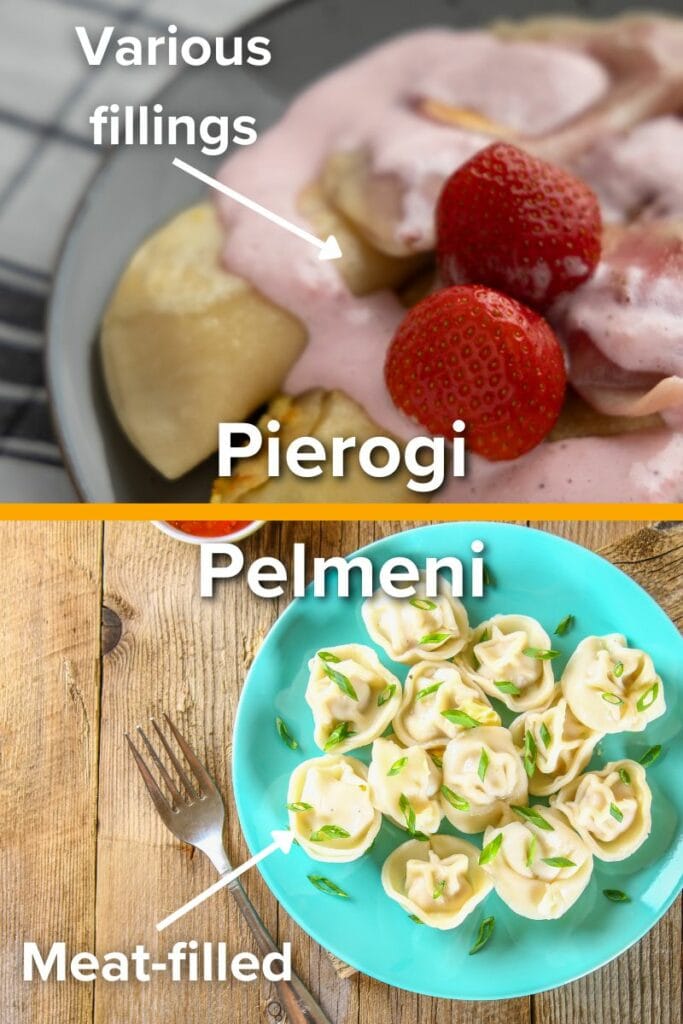Polish Pierogi vs. Russian Pelmeni: What are the Differences?
This post may contain affiliate links. Read our privacy policy.
Both pierogi and pelmeni are filled dumplings cooked in boiling water. The primary distinction is their size and filling: pelmeni are typically smaller, containing a raw mixture of meat and spices, whereas pierogi can be larger with a diverse range of fillings.
Pelmeni can be seen as a specific subtype of pierogi: smaller and traditionally filled with spiced meat or mushrooms. They bear a close resemblance to Polish uszka, another variant of pierogi, and regular meat pierogi.

That’s pierogi vs. pelmeni 101.
Let’s delve deeper into their key differences.
Ingredients
The dough ingredients for both dumplings are quite similar, usually comprising:
- Flour
- Water
- Salt
- Fat (oil or eggs for pierogi; eggs for pelmeni. Butter can also be used, as seen in this recipe).
- (Optional) Dairy ingredients like sour cream or buttermilk.
Of course, the dough ingredients depend on the recipe, and there are probably hundreds of options to choose from, each slightly different than the next one.
When it comes to stuffing, pelmeni are typically filled with a meat mixture that consists of ground meat, diced onion, and simple spices like salt and pepper.
Pierogi are much more versatile. So while you might only be familiar with the classic potato and cheese pierogi, you can make them with almost any filling, as long as it has the proper texture.
(Check out my article on pierogi fillings for 10+ options to choose from.)
Preparation

Both pierogi and pelmeni share a three-step preparation process:
- Knead the dough.
- Prepare the filling.
- Form and cook the dumplings.
A crucial distinction is that pelmeni contain raw meat, while pierogi fillings are pre-cooked unless they’re safe to eat raw. That pre-cooking is what you can see me do in my meat pierogi recipe, which could just as well be a pelmeni recipe if I skipped cooking the meat and went with much smaller dough circles.
Flavor
Compared to meat pierogi, pelmeni are juicier, as all the juice that’s in the raw meat is enclosed in the dumpling. For meat pierogi, those juices evaporate when you cook the meat, making the pierogi drier but still tasting great nonetheless.
Both pierogi and pelmeni taste great right after cooking, and you can serve them as-is or top with something as simple as a dollop of sour cream or some melted butter.
(Check out my list of pierogi toppings if you’re looking for some ideas.)
This contrasts with dumplings like gnocchi, which often require a sauce to elevate their taste. For more on this, see my pierogi vs. gnocchi article.
Shape & Size

Pelmeni are generally about half the size of pierogi. While pierogi often sport a half-moon shape, pelmeni resemble small crescent moons or ear-like forms, with the crescent ends joined together.
(Some might even say those ear-like dumplings look like a diaper.)
That said, both dumplings can adopt different shapes, depending on whether they’re formed by hand or using a mold or maker to speed things up.
Origin
While pierogi might trace their origins to Asia, they’ve become emblematic of Polish cuisine. Pelmeni, on the other hand, hail from either the Siberian or Ural regions of what’s now Russia, gaining popularity among Russian hunters.
That shouldn’t come as a surprise, as often neighboring countries share lots of culinary similarities and have similar recipes under different names.
